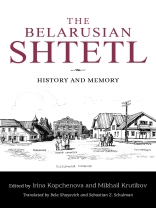For centuries Jewish shtetls were an active part of Belarusian life; today, they are gone. The Belarusian Shtetl is a landmark volume which offers, for the first time in English, an illuminating look at the shtetls’ histories, the lives lived and lost in them, and the memories, records, and physical traces of these communities that remain today.
Since 2012, under the auspices of the Sefer Center for University Teaching of Jewish Civilization, teams of scholars and students from many different disciplines have returned to the sites of former Jewish shtetls in Belarus to reconstruct their past. These researchers have interviewed a wide range of both Jews and non-Jews to find and document traces of Shtetl history, to gain insights into community memories, and to discover surviving markers of identity and ethnic affiliation. In the process, they have also unearthed evidence from old cemeteries and prewar houses and the stories behind memorials erected for Holocaust victims.
Drawing on the wealth of information these researchers have gathered, The Belarusian Shtetl creates compelling and richly textured portraits of the histories and everyday lives of each shtetl. Important for scholars and accessible to the public, these portraits set out to return the Jewish shtetls to their rightful places of prominence in the histories and legacies of Belarus.
Daftar Isi
Acknowledgments
Note on Geographical Names, Transliteration and Maps
Maps
Introduction, by Samuel D. Kassow, Irina Kopchenova, and Mikhail Krutikov
History, Folklore, Ethnography
1. Between Mestechko and Shtetl: Ethnicity and Religion in Belarusian Small Towns, 1800s–1930s, by Ina Sorkina
2. The Soviet Belarusian Shtetl: Between Tradition and Modernization in the 1920s and 1930s, by Arkadi Zeltser
3. Days of Remembrance for Jews of the Russo-Belarusian Borderlands, by Svetlana Amosova
4. Why Hitler Didn’t Like the Jews: The Folklore Version of the Reasons Behind the Holocaust, by Andrei B. Moroz
Hlybokaye: Memories of the Shtetl
5. The Death of the Shtetl of Hlybokaye through the Eyes of Its Teenagers, by Julia Bernstein
6. A Family between the Ghetto and Red Army Partisans: Two Holocaust Testimonies from Hlybokaye, by Julia Bernstein
7. Daily Life in the Hlybokaye Ghetto: Photographs from the United States Holocaust Memorial Museum, by Irina Kopchenova
8. Memory on Demand: The Jewish Past in Today’s Hlybokaye, by Mikhail Lurie and Natalia Savina
Appendix
The Shtetl of Zhaludok: A Memoir, by Miron Mordukhvich
Index
Tentang Penulis
Irina Kopchenova is Educational Programs Coordinator at the SEFER Center, Moscow, and Junior Research Fellow at the Institute of Slavic Studies in the Russian Academy of Science. She is editor of The Shtetl of Hlybokaye in Contemporary Cultural Memory and Jews on the Map of Lithuania: The Case of Biržai. Mikhail Krutikov is author of four books and co-editor of ten collected volumes on various aspects of Yiddish culture. He is Professor of Slavic Languages and Literatures and Preston R. Tisch Professor of Judaic Studies at the University of Michigan.












